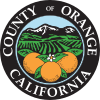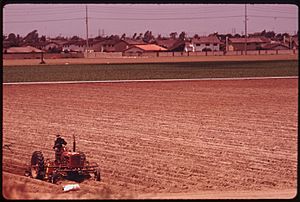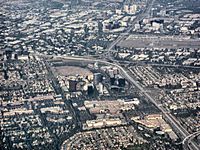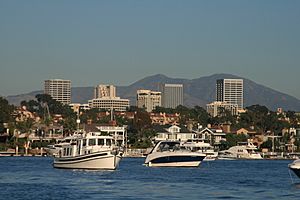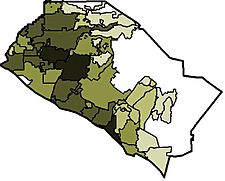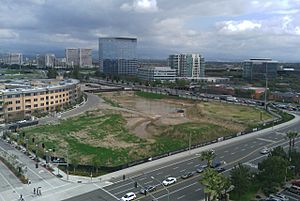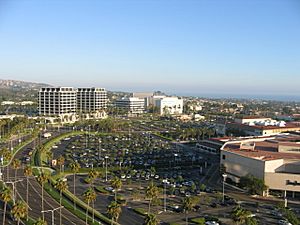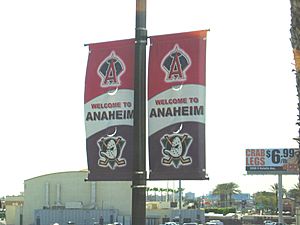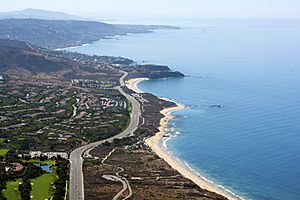Orange County, California facts for kids
Quick facts for kids
Orange County
|
|||
|---|---|---|---|
|
Clockwise from top: aerial view of the coast of Newport Beach; Mission San Juan Capistrano; Laguna Beach; Knott’s Berry Farm; and Sleeping Beauty Castle in Disneyland
|
|||
|
|||
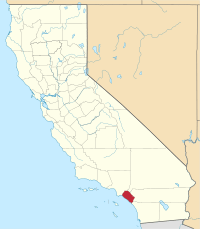
Location in California
|
|||
| Country | United States | ||
| State | California | ||
| Region | Greater Los Angeles | ||
| Incorporated | August 1, 1889 | ||
| Named for | The orange, named so the county would sound like a semi-tropical, mediterranean region to people from the east coast | ||
| County seat | Santa Ana | ||
| Largest city | Anaheim (population) Irvine (area) |
||
| Government | |||
| • Type | Council–CEO | ||
| • Body | |||
| Area | |||
| • Total | 948 sq mi (2,460 km2) | ||
| • Land | 799 sq mi (2,070 km2) | ||
| • Water | 157 sq mi (410 km2) | ||
| Highest elevation | 5,690 ft (1,730 m) | ||
| Population | |||
| • Total | 3,186,989 | ||
| • Estimate
(2023)
|
3,186,997 |
||
| • Density | 3,989/sq mi (1,540/km2) | ||
| Demonym(s) | Orange Countian | ||
| GDP | |||
| • Total | 4.177 billion (2022) | ||
| Time zone | UTC−8 (Pacific Time Zone) | ||
| • Summer (DST) | UTC−7 (Pacific Daylight Time) | ||
| Area codes | 562, 657/714, 949 | ||
| Congressional districts | 38th, 40th, 45th, 46th, 47th, 49th | ||
Orange County (often called O.C.) is a county in Southern California, United States. It's part of the larger Los Angeles metropolitan area. In 2020, over 3.1 million people lived here, making it the third most populated county in California. It's also more populated than many U.S. states!
Even though it has many suburbs, Orange County is the second most crowded county in California. The biggest cities are Anaheim, Santa Ana, and Irvine. Each of these cities has more than 300,000 residents. Santa Ana is the main city where the county government is located, known as the county seat. Six cities in Orange County are right on the Pacific Ocean: Seal Beach, Huntington Beach, Newport Beach, Laguna Beach, Dana Point, and San Clemente.
Orange County is known for its many fun places to visit. These include Disneyland Resort, Knott's Berry Farm, Mission San Juan Capistrano, and beautiful beaches. It's also home to important universities like the University of California, Irvine (UCI).
Contents
History of Orange County
Long ago, Native American groups like the Tongva, Acjachemen, and Luiseño lived in this area. In 1769, a Spanish explorer named Gaspar de Portolá visited. Later, another Spanish expedition named the area "Valle de Santa Ana." In 1776, Mission San Juan Capistrano was built, becoming the first lasting European settlement.
During the 1860s, a big drought hurt the cattle ranching business. This led to large areas of land being owned by a few wealthy people. In 1887, silver was found in the Santa Ana Mountains, which brought more settlers to the area, helped by new railroads.
Because of this growth, Orange County was created as a separate area from Los Angeles County on March 11, 1889. The county was named after the orange fruit. This was done to make the area sound like a warm, sunny paradise, encouraging more people to move there.
In the early days, growing citrus fruits, avocados, and getting oil from the ground were very important for the economy. Transportation improved a lot in 1904 when a trolley line connected Los Angeles to Santa Ana and Newport Beach. This made Orange County a popular weekend getaway for Hollywood stars. Later, in the 1920s, major roads like U.S. Route 101 (now mostly Interstate 5) made travel even easier.
After World War II, farming became less important. However, the county grew very quickly. The completion of Interstate 5 in 1954 made Orange County a "bedroom community." This meant many people lived here and drove to work in nearby cities, especially in the aerospace and manufacturing industries. In 1955, Disneyland opened, which gave Orange County another big boost.
In 1969, Richard Nixon, who was born in Yorba Linda, became the 37th President of the United States. By the 1980s, Orange County's population reached over two million people, making it the second most populated county in California.
In 1994, Orange County faced a big financial challenge. The county had invested money in risky ways and lost a lot. This led to the county declaring bankruptcy. It was the largest local government bankruptcy in U.S. history at the time. The county worked hard and recovered from this financial problem by 1996.
More recently, there have been discussions about how to use land. For example, a former military air base, Marine Corps Air Station El Toro, was planned to become an airport. However, after public votes, it was decided that it would become a large park called the Orange County Great Park instead.
Geography and Landscape
Orange County covers about 948 square miles. About 791 square miles are land, and 157 square miles are water. It's the smallest county in Southern California. The weather here is usually warm, with an average temperature of about 68 degrees Fahrenheit (20 degrees Celsius).
The Pacific Ocean borders Orange County to the southwest. To the north is Los Angeles County, to the northeast are San Bernardino County and Riverside County, and to the southeast is San Diego County.
The western part of the county is a flat coastal area, while the southeastern part has hills that lead up to the Santa Ana Mountains. Most people in Orange County live in two main valleys near the coast: the Santa Ana Valley and the Saddleback Valley. The highest point in the county is Santiago Peak, which is about 5,689 feet (1,734 meters) tall. This peak and nearby Modjeska Peak form a ridge called Saddleback, which you can see from almost anywhere in the county.
The Santa Ana River is the main river flowing through the middle of the county. Other important waterways include Santiago Creek, Aliso Creek, and San Juan Creek. Laguna Beach has the county's only natural lakes, called Laguna Lakes.
People sometimes talk about "North Orange County" and "South Orange County." This is more about culture and how developed the areas are. North Orange County is older and closer to Los Angeles, while South Orange County is newer and often has more expensive homes. These areas are different in terms of population, economy, and culture.
Nearby Counties
- Los Angeles County (North)
- San Diego County (South)
- Riverside County (East)
- San Bernardino County (Northeast)
Protected Natural Areas
People of Orange County
| Historical population | |||
|---|---|---|---|
| Census | Pop. | %± | |
| 1890 | 13,589 | — | |
| 1900 | 19,696 | 44.9% | |
| 1910 | 34,436 | 74.8% | |
| 1920 | 61,375 | 78.2% | |
| 1930 | 118,674 | 93.4% | |
| 1940 | 130,760 | 10.2% | |
| 1950 | 216,224 | 65.4% | |
| 1960 | 703,925 | 225.6% | |
| 1970 | 1,420,386 | 101.8% | |
| 1980 | 1,932,709 | 36.1% | |
| 1990 | 2,410,556 | 24.7% | |
| 2000 | 2,846,289 | 18.1% | |
| 2010 | 3,010,232 | 5.8% | |
| 2020 | 3,186,989 | 5.9% | |
| 2023 (est.) | 3,135,755 | 4.2% | |
| U.S. Decennial Census 1790–1960 1900–1990 |
|||
Orange County is a very diverse place! In 2020, the population was 3,186,989. Many different groups of people live here. About 37.6% of the people are White (not Hispanic). About 21.9% are Asian, and 34.1% are Hispanic or Latino.
The Hispanic and Latino population mostly comes from Mexico. Among the Asian population, many people are from Vietnam, Korea, China, and the Philippines. Orange County has the largest percentage of Asian Americans in Southern California. There are also many people who follow the Muslim faith in the county.
In 2000, about 58.6% of people spoke only English at home. However, many also spoke Spanish (25.3%), Vietnamese (4.7%), Korean (1.9%), or Chinese (1.5%). By 2009, nearly 45% of residents spoke a language other than English at home, showing how diverse the county has become.
The people who live in Orange County are sometimes called "Orange Countians."
Economy and Business
Orange County is home to many large companies. Some well-known ones include Ingram Micro and Broadcom in Irvine, and Western Digital in Lake Forest. Irvine is also a hub for many new technology companies and major international businesses like Mazda, Toshiba, Toyota, and Kia.
Fashion is also a big industry here. Companies like Oakley, Inc. and Hurley International have their headquarters in Orange County. Many popular restaurant chains, such as Taco Bell, El Pollo Loco, and In-N-Out Burger, also have their main offices in Irvine.
Shopping Fun
Orange County is a great place to shop! South Coast Plaza in Costa Mesa is the biggest mall in California and one of the largest in the world. Other large malls include Brea Mall, Irvine Spectrum Center, and Fashion Island in Newport Beach. For a unique experience, Downtown Disney offers special shopping and entertainment. There are also many smaller shopping centers and outlet malls.
Tourism and Attractions
Tourism is a huge part of Orange County's economy. Anaheim is a major tourist spot, thanks to the Disneyland Resort, which includes Disneyland Park and Disney California Adventure Park. Disneyland is one of the most visited theme parks globally!
Another popular theme park is Knott's Berry Farm in Buena Park, which gets millions of visitors each year. Orange County also has three water parks: Wild Rivers in Irvine, Knott's Soak City in Buena Park, and Great Wolf Lodge in Anaheim.
The beautiful beaches are a big draw too. Huntington Beach is famous for surfing and is known as "Surf City, U.S.A." You can find many surfing competitions there. "The Wedge" in Newport Beach is a famous spot for body surfing.
Other interesting places to visit include Mission San Juan Capistrano, known for its migrating swallows. The Richard Nixon Presidential Library and Museum in Yorba Linda is also a National Historic Landmark.
Arts and Culture
Orange County has a warm Mediterranean climate and over 40 miles (64 km) of beaches, which attract many tourists. The beach cities, like Huntington Beach and Laguna Beach, are known for their surf culture.
Little Saigon in Orange County is a special place. It has the largest group of Vietnamese people living outside of Vietnam. There are also many Taiwanese, Filipino, Chinese, and Korean communities, especially in western Orange County. You can find many Asian-influenced shopping centers and delicious food here. The 626 Night Market at the OC Fair & Event Center is a popular event for trying Asian and fusion foods, seeing art, and enjoying live shows.
Historical sites include the Old Towne, Orange Historic District in the City of Orange, which still looks like it did in the 1950s. Famous religious buildings include Christ Cathedral (formerly the Crystal Cathedral) in Garden Grove, and Saddleback Church in Lake Forest, which is one of the largest churches in the U.S.
Religion in Orange County
Orange County is home to many different religious groups and places of worship. In 2014, it had one of the highest numbers of religious organizations among all U.S. counties.
Some notable religious centers include:
- The Newport Beach California Temple, a temple for the Church of Jesus Christ of Latter-day Saints.
- Christ Cathedral in Garden Grove, which is the main church for the Roman Catholic Diocese of Orange.
- Large Jewish synagogues like University Synagogue in Irvine and Temple Beth El in Aliso Viejo.
- Several mosques like the Islamic Center of Irvine and the Islamic Society of Orange County in Garden Grove.
- Pao Fa Temple in Irvine, one of the largest Buddhist temples in the United States.
- The Jain Center of Southern California in Buena Park, a major center for followers of the Jain faith.
- The Sikh Center of Orange County in Santa Ana.
Sports and Recreation
Huntington Beach is a big spot for sports. It hosts the annual U.S. Open of Surfing and AVP Pro Beach Volleyball events. Orange County's active outdoor lifestyle means many people enjoy surfing, skateboarding, mountain biking, and other outdoor activities.
Orange County has two major professional sports teams:
- The Los Angeles Angels are a Major League Baseball team. They won the World Series in 2002.
- The Anaheim Ducks are a National Hockey League team. They won the Stanley Cup in 2007.
The Orange County SC is a professional United Soccer League team that plays its home games at Championship Soccer Stadium in the Orange County Great Park.
Education and Learning
Orange County has many colleges and universities. These include:
- University of California, Irvine (UCI)
- California State University, Fullerton (CSUF)
- Chapman University
- Several community colleges like Orange Coast College and Santa Ana College.
The Orange County Department of Education also oversees 28 different school districts for younger students.
Media and News
Orange County gets its TV and radio from the media in Los Angeles. However, there are also local stations. KOCE-TV is the main PBS station, and KDOC-TV is another local TV station.
There are several radio stations based in Orange County, playing different types of music and news. For example, KSBR 88.5 FM plays jazz music, and KWIZ 96.7 FM plays regional Mexican music. The Los Angeles Angels baseball team even has its own sports radio station, KLAA.
For local news, people read the Orange County Register and Voice of OC. Orange Coast is a lifestyle magazine that has been published since 1974.
Getting Around Orange County
Getting around Orange County mostly relies on the Orange County Transportation Authority (OCTA). OCTA manages the county's bus system and helps build and maintain roads and highways.
Major Roads
Orange County has several major highways that help people travel. The most important ones are Interstate 5, Interstate 405, and Interstate 605. Other important state highways include California State Route 91, California State Route 22, and California State Route 57. Some of these are toll roads, meaning you pay to use them.
Bus Service
OCTA runs a large bus network with thousands of stops and many routes. They are also replacing older buses with new ones that run on natural gas, which is better for the environment.
Train Service
Since 1992, Metrolink has operated commuter trains through Orange County. These trains help people travel to and from work. There are also Amtrak passenger trains, like the Pacific Surfliner, which stop at several stations in Orange County.
A new streetcar line called OC Streetcar is being built to connect Downtown Santa Ana to the Santa Ana train station. It is expected to open in 2023.
Boat Travel
- The Balboa Island Ferry carries cars and passengers between Balboa Peninsula and Balboa Island in Newport Beach.
- The Catalina Flyer and Catalina Express offer daily trips to Catalina Island, a popular island getaway.
Air Travel
Orange County's main airport is John Wayne Airport (SNA). It's located near Newport Beach, Costa Mesa, and Irvine. In 2014, over 9 million passengers used the airport!
Communities in Orange County
Orange County has many cities and smaller communities.
Cities
- Aliso Viejo
- Anaheim
- Brea
- Buena Park
- Costa Mesa
- Cypress
- Dana Point
- Fountain Valley
- Fullerton
- Garden Grove
- Huntington Beach
- Irvine
- La Habra
- La Palma
- Laguna Beach
- Laguna Hills
- Laguna Niguel
- Laguna Woods
- Lake Forest
- Los Alamitos
- Mission Viejo
- Newport Beach
- Orange
- Placentia
- Rancho Santa Margarita
- San Clemente
- San Juan Capistrano
- Santa Ana (county seat)
- Seal Beach
- Stanton
- Tustin
- Villa Park
- Westminster
- Yorba Linda
Unincorporated Communities
These are communities that are not part of any city and are governed directly by the county.
Planned Communities
Orange County is known for its many planned communities. These are large neighborhoods or cities that were designed and built all at once. Some famous examples include the City of Irvine, Coto de Caza, Anaheim Hills, and Mission Viejo.
Population Ranking of Cities
The following table shows the population of the main cities and communities in Orange County, based on the 2010 census.
† county seat
| Rank | City/Town/etc. | Municipal type | Population (2010 Census) |
|---|---|---|---|
| 1 | Anaheim | City | 336,265 |
| 2 | † Santa Ana | City | 324,528 |
| 3 | Irvine | City | 212,375 |
| 4 | Huntington Beach | City | 189,992 |
| 5 | Garden Grove | City | 170,883 |
| 6 | Orange | City | 136,416 |
| 7 | Fullerton | City | 135,161 |
| 8 | Costa Mesa | City | 109,960 |
| 9 | Mission Viejo | City | 93,305 |
| 10 | Westminster | City | 89,701 |
| 11 | Newport Beach | City | 85,186 |
| 12 | Buena Park | City | 80,530 |
| 13 | Lake Forest | City | 77,264 |
| 14 | Tustin | City | 75,540 |
| 15 | Yorba Linda | City | 64,234 |
| 16 | San Clemente | City | 63,522 |
| 17 | Laguna Niguel | City | 62,979 |
| 18 | La Habra | City | 60,239 |
| 19 | Fountain Valley | City | 55,313 |
| 20 | Placentia | City | 50,533 |
| 21 | Rancho Santa Margarita | City | 47,853 |
| 22 | Aliso Viejo | City | 47,823 |
| 23 | Cypress | City | 47,802 |
| 24 | Brea | City | 39,282 |
| 25 | Stanton | City | 38,186 |
| 26 | San Juan Capistrano | City | 34,953 |
| 27 | Dana Point | City | 33,351 |
| 28 | Laguna Hills | City | 30,344 |
| 29 | North Tustin | CDP | 24,917 |
| 30 | Seal Beach | City | 24,168 |
| 31 | Ladera Ranch | CDP | 22,980 |
| 32 | Laguna Beach | City | 22,723 |
| 33 | Laguna Woods | City | 16,192 |
| 34 | La Palma | City | 15,568 |
| 35 | Coto de Caza | CDP | 14,866 |
| 36 | Los Alamitos | City | 11,449 |
| 37 | Rossmoor | CDP | 10,244 |
| 38 | Midway City | CDP | 8,485 |
| 39 | Villa Park | City | 5,812 |
| 40 | Sunset Beach | CDP (annexed by city of Huntington Beach in 2011) | 971 |
| 41 | Las Flores | CDP | 5,971 |
Orange County in Pop Culture
Orange County has been the setting for many books, movies, and TV shows.
- The first story about Zorro, The Curse of Capistrano, was set in San Juan Capistrano.
- Many suspense novels by writer Dean Koontz, who lives in Newport Beach, are set in Orange County.
- Popular TV shows set here include the drama The O.C., the comedy Arrested Development, and the reality show The Real Housewives of Orange County. These shows often highlight the fancy lifestyles of the county's wealthier residents.
See also
 In Spanish: Condado de Orange (California) para niños
In Spanish: Condado de Orange (California) para niños








